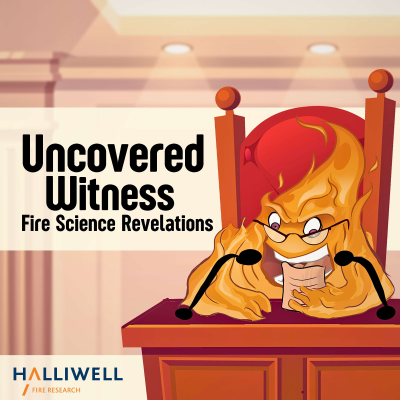
Uncovered Witness: Fire Science Revelations
Podcast by Wojciech Wegrzynski
In this podcast, I am joining HALLIWELL Fire Research to provide a fundamental insight into fire science. With content that does not require any prior...
Start 7 days free trial
After trial, only 79,00 kr. / month.Cancel anytime.
All episodes
9 episodesWelcome to Season 2 of Uncovered Witness: Fire Science Revelations! This season, the show's theme is Humans as part of a fire safety engineered system. In this series, we will unravel our understanding of human behaviour in fires and how this complex behaviour may be accounted for in the fire-safe design of buildings. Our understanding of the occupant response, decision-making process and biases may influence our design of exits and improve (or impede) the egress process. In the final episode of Season 2, we continue the discussion on familiarity, which is explained through the theory of affiliation. Why clustering of people is a more familiar state than evacuating alone? How may understanding the familiarity of exits ruin our evacuation plan, and why should the main exit serve the occupants as their main escape route? Here, we demonstrate how understanding human behaviour theories may help us engineer better. In the final part of this episode, we deal with some damaging myths related to human behaviour in fires. First, we discuss the altruistic behaviour of people, showing how compassion is more widely observed in fires compared to an individualistic approach. Then, we discuss the definition of Panic - one as understood by the scientists studying the phenomenon and the other as understood by media/layman. We discuss why panic is often used as a clickbait, scapegoat or cover-up of more serious technical issues (often all three at the same time). It is imperative that engineers understand the true concept of panic and other aspects of human behaviour and then use this knowledge to design better buildings. Guests featured in this podcast episode: * Prof. Daniel Nilsson, University of Canterbury, Halliwell Fire Research Thank you for being us in the Season 2 of the Uncovered Witness. Follow @WojciechITB at Twitter or https://www.linkedin.com/in/wojciech-wegrzynski/ and https://www.linkedin.com/company/fireresearchgroupltd for current information about new episode releases. Season 3 is coming soon, and this time, we will discuss the legal skeleton of a building and the responsibilities for building defects related to fire safety! This show is produced by the Fire Science Media for Halliwell Fire Research. Executive producer - Monika Węgrzyńska, scripting and production - Monika and Wojciech Węgrzyńscy, sound engineer - Mikołaj Jarząbek. All rights reserved. 2024.
Welcome to Season 2 of Uncovered Witness: Fire Science Revelations! This season, the show's theme is Humans as part of a fire safety engineered system. In this series, we will unravel our understanding of human behaviour in fires and how this complex behaviour may be accounted for in the fire-safe design of buildings. Our understanding of the occupant response, decision-making process and biases may influence our design of exits and improve (or impede) the egress process. This episode is all about human behaviour theories - useful concepts that allow us to explain some of the behaviour observed in real-world fire incidents and evacuation drills. We learn about the behavioural sequence model, which explains the sequence of actions taken in the pre-evacuation time. Then, we move to the social influence model, which explains how normative and informative social influence influences people's actions. The first relates to the rules and social norms in the environment where the evacuation occurs and how people are afraid to not break those rules even while in danger. The informative social influence refers to how we use others as our source of information or to confirm our own choices. Further in the episode, we discuss the role-rule model and how our roles in our normal lives remain the same in the evacuation context. We try to define how these roles may be disturbed and how establishing a new hierarchy for evacuation may streamline the process. Guests featured in this podcast episode: * Prof. Daniel Nilsson, University of Canterbury, Halliwell Fire Research * Josh Gibbons, Halliwell Fire Research This show is produced by the Fire Science Media for Halliwell Fire Research. Executive producer - Monika Węgrzyńska, scripting and production - Monika and Wojciech Węgrzyńscy, sound engineer - Mikołaj Jarząbek. All rights reserved. 2024.
Welcome to Season 2 of Uncovered Witness: Fire Science Revelations! This season, the show's theme is Humans as part of a fire safety engineered system. In this series, we will unravel our understanding of human behaviour in fires and how this complex behaviour may be accounted for in the fire-safe design of buildings. Our understanding of the occupant response, decision-making process and biases may influence our design of exits and improve (or impede) the egress process. In the second episode of the series, we focus on the actions taken by the occupants from the moment they receive information about the fire to the moment when they start their evacuation. This includes response to fire cues - from the flames and smoke, through evacuation alarms and observing the reaction of others. We go into how people perceive the threat from a fire and how this perception is affected by the presence of others. With the examples of the Beverly Hills Supper Club and MGM Grand fires, we illustrate some of the most fundamental concepts related to occupant response and wayfinding. Finally, we discuss the group behaviours, touching also on the definitions of rational and irrational behaviour. Useful links: * Max Kinateder et. al. review on risk perception in fires [https://link.springer.com/article/10.1186/s40038-014-0005-z] * Erica Kuligowski et. al. guidance on behaviour modelling, including the PADM framework mentioned in the episode [https://www.ncbi.nlm.nih.gov/pmc/articles/PMC5292781/] * Fire Science Show episode 019 with Erica Kuligowski on modelling human behaviour in wildfire evacuations [https://www.firescienceshow.com/019-modelling-human-behaviour-in-wildfire-evacuation-with-erica-kuligowski/] Guests featured in this podcast episode: * Prof. Daniel Nilsson, University of Canterbury, Halliwell Fire Research * Josh Gibbons, Halliwell Fire Research This show is produced by the Fire Science Media for Halliwell Fire Research. Executive producer - Monika Węgrzyńska, scripting and production - Monika and Wojciech Węgrzyńscy, sound engineer - Mikołaj Jarząbek. All rights reserved. 2024.
Welcome to Season 2 of Uncovered Witness: Fire Science Revelations! This season, the show's theme is Humans as part of a fire safety engineered system. In this series, we will unravel our understanding of human behaviour in fires and how this complex behaviour may be accounted for in the fire-safe design of buildings. Our understanding of the occupant response, decision-making process and biases may influence our design of exits and improve (or impede) the egress process. In the first episode of this series, we cover the approach used to account for complex human behaviour in assessing the Required Safe Evacuation Time (RSET). This is commonly done by accounting for a delay in the evacuation process that is a product of complex human behaviour between receiving a fire cue and making the decision to evacuate. Human behaviour may be considered repetitive over similar populations and occupations despite the complexities. This allows us to study this process from a statistical perspective—on average, how long does it take for people to respond to specific cues in specific circumstances? The answer is not a single number but a population-wide distribution of the pre-evacuation time, which can then be a useful input for our calculations and modelling. In this episode, we discuss the history of this approach, the data sources and their validity. We also cover how cultural and societal context may influence the resulting time distribution. Useful links: * The pre-evacuation Database research paper mentioned in the podcast episode. [https://www.nist.gov/publications/pre-evacuation-database-use-egress-simulations] * Fire Science Show episode 134 - interview with prof. David Purser [https://www.firescienceshow.com/134-fire-fundamentals-pt-5-the-evacuation-equation-with-david-purser/] * The standard widely referred to in the episode was BS PD 7974-6, available to purchase through the BSI [https://knowledge.bsigroup.com/products/application-of-fire-safety-engineering-principles-to-the-design-of-buildings-human-factors-life-safety-strategies-occupant-evacuation-behaviour-and-condition-sub-system-6?version=standard] Guests featured in this podcast episode: * Prof. Daniel Nilsson, University of Canterbury, Halliwell Fire Research * Prof. David Purser - highlights from the episode 134 of the Fire Science Show [https://www.firescienceshow.com/134-fire-fundamentals-pt-5-the-evacuation-equation-with-david-purser/] This show is produced by the Fire Science Media for Halliwell Fire Research. Executive producer - Monika Węgrzyńska, scripting and production - Monika and Wojciech Węgrzyńscy, sound engineer - Mikołaj Jarząbek. All rights reserved. 2024.
In this episode of The Uncovered Witness, I've invited Kristen E. Lange from Ogden Murphy Wallace P.L.L.C. In her expertise, Kristen has worked on court cases related to fire safety; in those cases, she has worked with expert witnesses who were fire safety engineers. Trying to tap into this experience, we try to identify "who" is the expert witness? What role are they in legal proceedings, and how is their expertise presented? Also, what makes an outstanding expert witness? This show is produced by the Fire Science Media for Halliwell Fire Research. Executive producer - Monika Węgrzyńska, scripting and production - Monika and Wojciech Węgrzyńscy, sound engineer - Mikołaj Jarząbek. All rights reserved. 2024.
Available everywhere
Listen to Podimo on your phone, tablet, computer or car!
A universe of audio entertainment
Thousands of audiobooks and exclusive podcasts
No ads
Don't waste time listening to ad breaks when listening to Podimo's content.
Start 7 days free trial
After trial, only 79,00 kr. / month.Cancel anytime.
Exclusive podcasts
Ad free
Non-Podimo podcasts
Audiobooks
20 hours / month



















